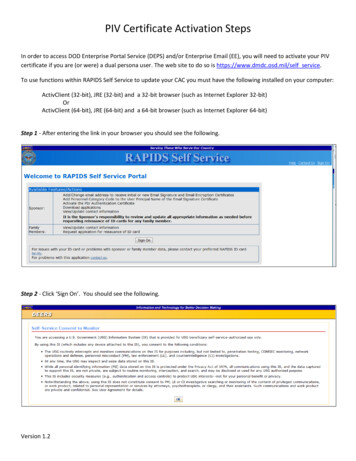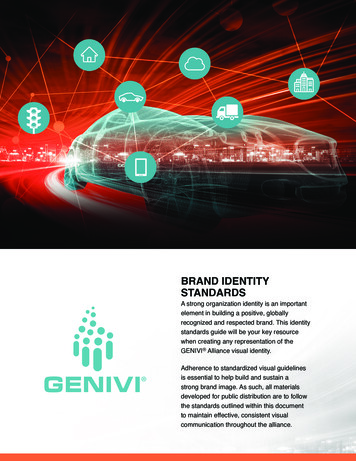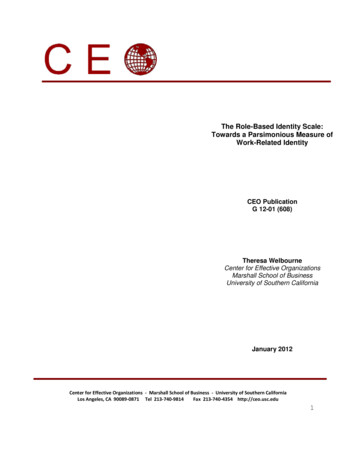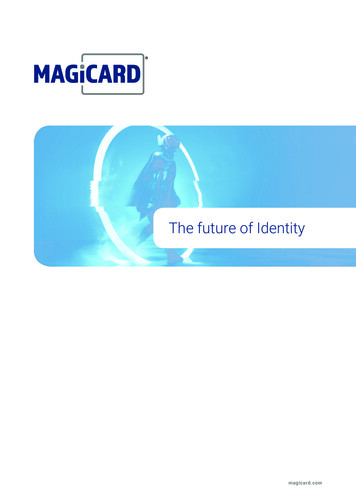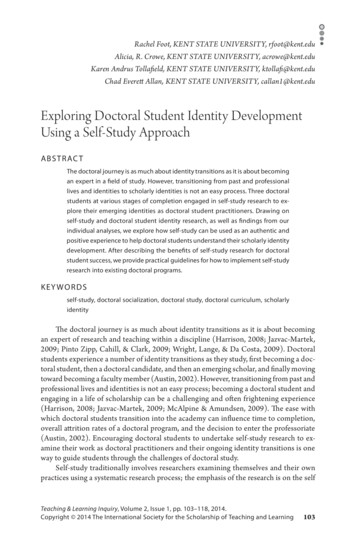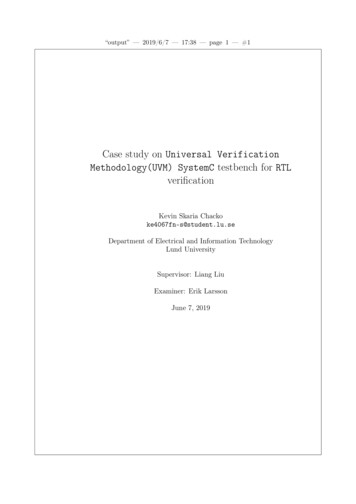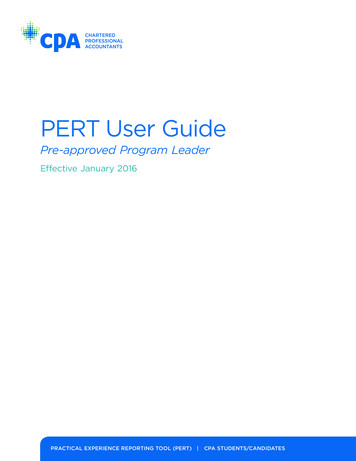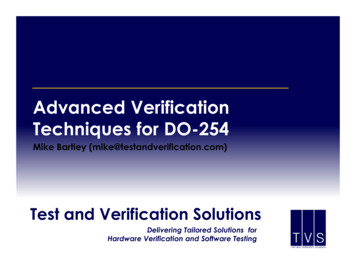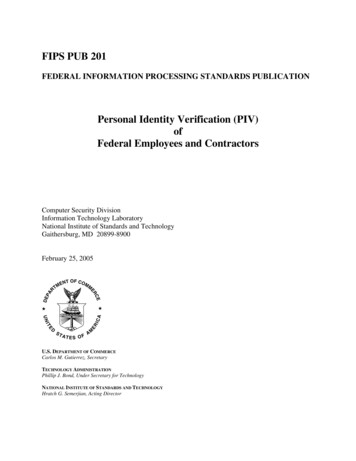
Transcription
FIPS PUB 201FEDERAL INFORMATION PROCESSING STANDARDS PUBLICATIONPersonal Identity Verification (PIV)ofFederal Employees and ContractorsComputer Security DivisionInformation Technology LaboratoryNational Institute of Standards and TechnologyGaithersburg, MD 20899-8900February 25, 2005U.S. DEPARTMENT OF COMMERCECarlos M. Gutierrez, SecretaryTECHNOLOGY ADMINISTRATIONPhillip J. Bond, Under Secretary for TechnologyNATIONAL INSTITUTE OF STANDARDS AND TECHNOLOGYHratch G. Semerjian, Acting Director
PERSONAL IDENTITY VERIFICATION (PIV) OF FEDERAL EMPLOYEES AND CONTRACTORSAcknowledgementsNIST would like to acknowledge the significant contributions of the Federal IdentityCredentialing Committee (FICC) and the Smart Card Interagency Advisory Board (IAB) forproviding valuable contributions to the development of technical frameworks on which thisstandard is based.Special thanks to those who have participated in the workshops and provided valuable technicalsuggestions in shaping this standard. NIST also acknowledges the comments received fromgovernment and industry organizations during the FIPS 201 preliminary draft review period.ii
PERSONAL IDENTITY VERIFICATION (PIV) OF FEDERAL EMPLOYEES AND CONTRACTORSFOREWORDThe Federal Information Processing Standards Publication Series of the National Institute of Standardsand Technology (NIST) is the official series of publications relating to standards and guidelines adoptedand promulgated under the provisions of the Federal Information Security Management Act (FISMA) of2002.Comments concerning FIPS publications are welcomed and should be addressed to the Director,Information Technology Laboratory, National Institute of Standards and Technology, 100 Bureau Drive,Stop 8900, Gaithersburg, MD 20899-8900.Dr. Shashi Phoha, DirectorInformation Technology LaboratoryABSTRACTThis standard specifies the architecture and technical requirements for a common identification standardfor Federal employees and contractors. The overall goal is to achieve appropriate security assurance formultiple applications by efficiently verifying the claimed identity of individuals seeking physical accessto Federally controlled government facilities and electronic access to government information systems.The standard contains two major sections. Part one describes the minimum requirements for a Federalpersonal identity verification system that meets the control and security objectives of Homeland SecurityPresidential Directive 12, including personal identity proofing, registration, and issuance. Part twoprovides detailed specifications that will support technical interoperability among PIV systems of Federaldepartments and agencies. It describes the card elements, system interfaces, and security controlsrequired to securely store, process, and retrieve identity credentials from the card. The physical cardcharacteristics, storage media, and data elements that make up identity credentials are specified in thisstandard. The interfaces and card architecture for storing and retrieving identity credentials from a smartcard are specified in Special Publication 800-73, Interfaces for Personal Identity Verification. Similarly,the interfaces and data formats of biometric information are specified in Special Publication 800-76,Biometric Data Specification for Personal Identity Verification.This standard does not specify access control policies or requirements for Federal departments andagencies.Keywords: Architecture, authentication, authorization, biometrics, credential, cryptography, FederalInformation Processing Standards (FIPS), HSPD 12, identification, identity, infrastructure, model,Personal Identity Verification, PIV, validation, verification.iii
PERSONAL IDENTITY VERIFICATION (PIV) OF FEDERAL EMPLOYEES AND CONTRACTORSFederal Information Processing Standards 2012005Announcing theStandard forPersonal Identity VerificationofFederal Employees and ContractorsFederal Information Processing Standards Publications (FIPS PUBS) are issued by the National Instituteof Standards and Technology (NIST) after approval by the Secretary of Commerce pursuant to theFederal Information Security Management Act (FISMA) of 2002.1. Name of Standard.FIPS PUB 201: Personal Identity Verification (PIV) of Federal Employees and Contractors.2. Category of Standard.Information Security.3. Explanation.Homeland Security Presidential Directive 12 (HSPD 12), dated August 27, 2004, entitled “Policy for aCommon Identification Standard for Federal Employees and Contractors,” directed the promulgation of aFederal standard for secure and reliable forms of identification for Federal employees and contractors. Itfurther specified secure and reliable identification that— Is issued based on sound criteria for verifying an individual employee’s identity Is strongly resistant to identity fraud, tampering, counterfeiting, and terrorist exploitation Can be rapidly authenticated electronically Is issued only by providers whose reliability has been established by an official accreditationprocess.The directive stipulated that the standard include graduated criteria, from least secure to most secure, toensure flexibility in selecting the appropriate level of security for each application. As promptly aspossible, but in no case later than eight months after the date of promulgation, executive departments andagencies are required to implement the standard for identification issued to Federal employees andcontractors in gaining physical access to controlled facilities and logical access to controlled informationsystems.4. Approving Authority.Secretary of Commerce.iv
PERSONAL IDENTITY VERIFICATION (PIV) OF FEDERAL EMPLOYEES AND CONTRACTORS5. Maintenance Agency.Department of Commerce, NIST, Information Technology Laboratory (ITL).6. Applicability.This standard is applicable to identification issued by Federal departments and agencies to Federalemployees and contractors (including contractor employees) for gaining physical access to Federallycontrolled facilities and logical access to Federally controlled information systems except for “nationalsecurity systems” as defined by 44 U.S.C. 3542(b)(2). Except as provided in HSPD 12, nothing in thisstandard alters the ability of government entities to use the standard for additional applications.Special-Risk Security Provision—The U.S. Government has personnel, facilities, and other assetsdeployed and operating worldwide under a vast range of threats (e.g., terrorist, technical, intelligence),particularly heightened overseas. For those agencies with particularly sensitive OCONUS threats, theissuance, holding, and/or use of PIV credentials with full technical capabilities as described herein mayresult in unacceptably high risk. In such cases of extant risk (e.g., to facilities, individuals, operations, thenational interest, or the national security), by the presence and/or use of full-capability PIV credentials,the head of a Department or independent agency may issue a select number of maximum securitycredentials that do not contain (or otherwise do not fully support) the wireless and/or biometriccapabilities otherwise required/referenced herein. To the greatest extent practicable, heads ofDepartments and independent agencies should minimize the issuance of such special-risk securitycredentials so as to support inter-agency interoperability and the President’s policy. Use of other riskmitigating technical (e.g., high-assurance on-off switches for the wireless capability) and proceduralmechanisms in such situations is preferable, and as such is also explicitly permitted and encouraged. Asprotective security technology advances, this need for this provision will be re-assessed as the standardundergoes the normal review and update process.7. Specifications.Federal Information Processing Standards (FIPS) 201 Personal Identity Verification (PIV) of FederalEmployees and Contractors.8. Implementations.The PIV standard consists of two parts—PIV-I and PIV-II. PIV-I satisfies the control objectives andmeets the security requirements of HSPD 12, while PIV-II meets the technical interoperabilityrequirements of HSPD 12. PIV-II specifies implementation and use of identity credentials on integratedcircuit cards for use in a Federal personal identity verification system.PIV Cards must be personalized with identity information for the individual to whom the card is issued,in order to perform identity verification both by humans and automated systems. Humans can use thephysical card for visual comparisons, whereas automated systems can use the electronically stored data onthe card to conduct automated identity verification.Federal departments and agencies may self-accredit, or use other accredited issuers, to issue identitycredentials for Federal employees and contractors until a government-wide PIV-II accreditation process isestablished. The standard also covers security and interoperability requirements for PIV Cards. Fundingpermitting, NIST plans to develop a PIV Validation Program that will test implementations forconformance with this standard. Additional information on this program will be published athttp://csrc.nist.gov/PIV-Project/Conformance/ as it becomes available.v
PERSONAL IDENTITY VERIFICATION (PIV) OF FEDERAL EMPLOYEES AND CONTRACTORSThe respective numbers of agency-issued 1) general credentials and 2) Special-risk credentials (issuedunder the Special-Risk Security Provision) shall be subject to annual reporting to the Office ofManagement and Budget (OMB) under the annual reporting process in a manner prescribed by OMB.9. Effective Date.This standard is effective immediately. Federal departments and agencies shall meet the requirements ofPIV-I no later than October 27, 2005, in accordance with the timetable specified in HSPD 12. The OMBhas advised NIST that it plans to issue guidance regarding the transition from PIV-I to PIV-II. It isanticipated that some Federal departments and agencies may begin with PIV-II, which would eliminatethe need for such a transition.10. Qualifications.The security provided by the PIV system is dependent on many factors outside the scope of this standard.Upon adopting this standard, organizations must be aware that the overall security of the personalidentification system relies on— Assurance provided by the issuer of an identity credential that the individual in possession of thecredential has been correctly identified Protection provided to an identity credential stored within the PIV Card and transmitted betweenthe card and the PIV issuance and usage infrastructure Protection provided to the identity verification system infrastructure and components throughoutthe entire life cycle.Although it is the intent of this standard to specify mechanisms and support systems that provide highassurance personal identity verification, conformance to this standard does not assure that a particularimplementation is secure. It is the implementer’s responsibility to ensure that components, interfaces,communications, storage media, managerial processes, and services used within the identity verificationsystem are designed and built in a secure manner.Similarly, the use of a product that conforms to this standard does not guarantee the security of the overallsystem in which the product is used. The responsible authority in each department and agency shallensure that an overall system provides the acceptable level of security.Because a standard of this nature must be flexible enough to adapt to advancements and innovations inscience and technology, the NIST will review this standard within five years to assess its adequacy. NISTplans to seek agency input in one year to see whether a full review of the standard is needed.11. Waivers.As per the Federal Information Security Management Act of 2002, waivers to Federal InformationProcessing Standards are not allowed.12. Where to Obtain Copies.This publication is available through the Internet by accessing http://csrc.nist.gov/publications/.vi
PERSONAL IDENTITY VERIFICATION (PIV) OF FEDERAL EMPLOYEES AND CONTRACTORSTable of Contents1.Introduction .11.11.21.32.Common Identification, Security, and Privacy Requirements .52.12.22.32.43.3.2Functional Components . 103.1.1 PIV Front-End Subsystem .113.1.2 PIV Card Issuance and Management Subsystem.123.1.3 Access Control Subsystem.12PIV Card Life Cycle Activities . 13PIV Front-End Subsystem .154.14.24.34.44.55.Control Objectives. 5PIV Identity Proofing and Registration Requirements. 5PIV Issuance and Maintenance Requirements . 6PIV Privacy Requirements . 7PIV System Overview.103.14.Purpose. 1Scope. 1Document Organization . 2Physical PIV Card Topology . 154.1.1 Printed Material .154.1.2 Tamper Proofing and Resistance .154.1.3 Physical Characteristics and Durability .164.1.4 Visual Card Topography.174.1.5 Logical Credentials .294.1.6 PIV Card Activation .29Cardholder Unique Identifier (CHUID) . 304.2.1 PIV CHUID Data Elements.304.2.2 Asymmetric Signature Field in CHUID .30Cryptographic Specifications . 31Biometric Data Specifications . 334.4.1 Biometric Data Collection, Storage, and Usage .344.4.2 Biometric Data Representation and Protection .354.4.3 Biometric Data Content .36Card Reader Specifications . 364.5.1 Contact Reader Specifications .374.5.2 Contactless Reader Specifications.374.5.3 PIN Input Device Specifications .37PIV Card Issuance and Management Subsystem .385.15.25.35.4Control Objectives and Interoperability Requirements. 38PIV Identity Proofing and Registration Requirements. 38PIV Issuance and Maintenance Requirements . 395.3.1 PIV Card Issuance.395.3.2 PIV Card Maintenance .39PIV Key Management Requirements. 415.4.1 Architecture .415.4.2 PKI Certificate.41vii
PERSONAL IDENTITY VERIFICATION (PIV) OF FEDERAL EMPLOYEES AND CONTRACTORS5.56.5.4.3 X.509 CRL Contents.435.4.4 Migration from Legacy PKIs .435.4.5 PKI Repository and OCSP Responder(s).43PIV Privacy Requirements . 44PIV Card Authentication .456.16.26.3Identity Authentication Assurance Levels . 456.1.1 Relationship to OMB’s E-Authentication Guidance .45PIV Card Authentication Mechanisms . 466.2.1 Authentication Using PIV Visual Credentials (VIS).466.2.2 Authentication Using the PIV CHUID .476.2.3 Authentication Using PIV Biometric.486.2.4 Authentication Using PIV Asymmetric Cryptography (PKI) .49PIV Support of Graduated Assurance Levels for Identity Authentication. 506.3.1 Physical Access.506.3.2 Logical Access.51List of AppendicesAppendix A— PIV Processes.52A.1Role Based Model. 52A.1.1 PIV Identity Proofing and Registration.52A.1.2 PIV Issuance .55A.2 System-Based Model. 57A.2.1 PIV Identity Proofing and Registration.57A.2.2 Roles and Responsibilities .57A.2.3 Identity Proofing and Enrollment .59A.2.4 Employer/Sponsor .59A.2.5 PIV Application Process .60A.2.6 PIV Enrollment Process.60A.2.7 Identity Verification Process .61A.2.8 Card Production, Activation and Issuance.62A.2.9 Suspension, Revocation and Destruction.62A.2.10 Re-issuance to Current PIV Credential Holders .62Appendix B— PIV Validation, Certification, and Accreditation .64B.1B.2B.3B.4Accreditation of PIV Service Providers . 64Security Certification and Accreditation of IT System(s) . 64Conformance of PIV Components to this Standard . 64Cryptographic Testing and Validation (FIPS 140-2 and algorithm standards) . 64Appendix C— Background Check Descriptions .66Appendix D— PIV Object Identifiers .67Appendix E— Physical Access Control Mechanisms .68Appendix F— Glossary of Terms, Acronyms, and Notations.69F.1Glossary of Terms. 69viii
PERSONAL IDENTITY VERIFICATION (PIV) OF FEDERAL EMPLOYEES AND CONTRACTORSF.2F.3Acronyms . 73Notations. 75Appendix G— References.76List of FiguresFigure 3-1. PIV System Notional Model.11Figure 3-2. PIV Card Life Cycle Activities .13Figure 4-1. Card Front—Printable Areas .21Figure 4-2. Card Front—Optional Data Placement—Example 1 .22Figure 4-3. Card Front—Optional Data Placement—Example 2 .23Figure 4-4. Card Front—Optional Data Placement—Example 3 .24Figure 4-5. Card Front—Optional Data Placement—Example 4 .25Figure 4-6. Card Back—Printable Areas and Required Data .26Figure 4-7. Card Back—Optional Data Placement—Example 1.27Figure 4-8. Card Back—Optional Data Placement—Example 2.28Figure A-1. PIV Identity Verification and Issuance.57List of TablesTable 6-1. Relationship Between PIV and E-Authentication Assurance Levels .46Table 6-2. Authentication for Physical Access.51Table 6-3. Authentication for Logical Access.51Table B-1. PIV System Components and Validation Requirements .64Table D-1. PIV Object Identifiers .67Table E-1. PIV Support of PACS Assurance Profiles .68ix
PERSONAL IDENTITY VERIFICATION (PIV) OF FEDERAL EMPLOYEES AND CONTRACTORS[This page intentionally left blank.]x
PERSONAL IDENTITY VERIFICATION (PIV) OF FEDERAL EMPLOYEES AND CONTRACTORS1.IntroductionAuthentication of an individual’s identity is a fundamental component of physical and logical accesscontrol processes. When an individual attempts to access security-sensitive buildings, computer systems,or data, an access control decision must be made. An accurate determination of identity is needed tomake sound access control decisions.A wide range of mechanisms is employed to authenticate identity, utilizing various classes of identitycredentials. For physical access, individual identity has traditionally been authenticated by use of paperor other non-automated, hand-carried credentials, such as driver’s licenses and badges. Accessauthorization to computers and data has traditionally been authenticated through user-selected passwords.More recently, cryptographic mechanisms and biometric techniques have been used in physical andlogical security applications, replacing or supplementing the traditional credentials.The strength of the authentication that is achieved varies, depending upon the type of credential, theprocess used to issue the credential, and the authentication mechanism used to validate the credential.This document establishes a standard for a Personal Identity Verification (PIV) system based on secureand reliable forms of identification credentials issued by the Federal government to its employees andcontractors. These credentials are intended to authenticate individuals who require access to Federallycontrolled facilities, information systems, and applications. This standard addresses requirements forinitial identity proofing, infrastructures to support interoperability of identity credentials, andaccreditation of organizations and processes issuing PIV credentials.1.1PurposeThis standard defines a reliable, government-wide PIV system for use in applications such as access toFederally controlled facilities and information systems. This standard has been developed within thecontext and constraints of Federal law, regulations, and policy based on information processingtechnology currently available and evolving.This standard specifies a PIV system within which common identification credentials can be created andlater used to verify a claimed identity. The standard also identifies Federal government-widerequirements for security levels that are dependent on risks to the facility or information being protected.1.2ScopeHomeland Security Presidential Directive 12 [HSPD 12], signed by the President on August 27, 2004,established the requirements for a common identification standard for identification credentials issued byFederal departments and agencies to Federal employees and contractors (including contractor employees)for gaining physical access to Federally controlled facilities and logical access to Federally controlledinformation systems. HSPD 12 directs the Department of Commerce to develop a Federal InformationProcessing Standards (FIPS) publication to define such a common identification credential. Inaccordance with HSPD 12, this standard defines the technical requirements for the identity credentialthat— Is issued based on sound criteria for verifying an individual employee’s identity Is strongly resistant to identity fraud, tampering, counterfeiting, and terrorist exploitation Can be rapidly authenticated electronically1
PERSONAL IDENTITY VERIFICATION (PIV) OF FEDERAL EMPLOYEES AND CONTRACTORS Is issued only by providers whose reliability has been established by an official accreditationprocess.This standard defines authentication mechanisms offering varying degrees of security. Federaldepartments and agencies will determine the level of security and authentication mechanisms appropriatefor their applications. This standard does not specify access control policies or requirements for Federaldepartments and agencies. Therefore, the scope of this standard is limited to authentication of anindividual’s identity. Access authorization decisions are outside the scope of this standard.1.3Document OrganizationThis standard is composed of two parts, PIV-I and PIV-II. The first part (PIV-I) describes the minimumrequirements for a Federal personal identification system that meets the control and security objectives ofHSPD 12, including personal identity proofing, registration, and issuance, but does not address theinteroperability of PIV Cards and systems among departments and agencies.The second part (PIV-II) provides detailed technical specifications to support the control and securityobjectives in PIV-I as well as interoperability among Federal departments and agencies. PIV-II describesthe policies and minimum requirements of a PIV Card that allows interoperability of credentials forphysical access and logical access. The physical card characteristics, storage media, and data elementsthat make up identity credentials are specified in this standard. The interfaces and card architecture forstoring and retrieving identity credentials from a smart card are specified in NIST Special Publication800-73 (SP 800-73), Interfaces for Personal Identity Verification. Similarly, the requirements forcollection and formatting of biometric information are specified in NIST Special Publication 800-76 (SP800-76), Biometric Data Specification for Personal Identity Verification.All sections in this document are normative (i.e., mandatory for compliance) unless specified asinformative (i.e., non-mandatory). Following is the structure of this document: Section 1, Introduction, provides background information for understanding the scope of thisstandard. This section is informative. Section 2, Common Identification, Security, and Privacy Requirements, outlines the requirementsfor PIV-I, by establishing the control and security objectives for compliance with HSPD 12. Section 3, PIV System Overview, se
personal identity verification system that meets the control and security objectives of Homeland Security Presidential Directive 12, including personal identity proofing, registration, and issuance. Part two provides detailed specifications that will support technical interoperabili
